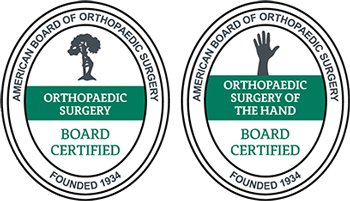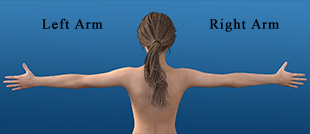New Study Delineates Benefit of Wrist Ganglia Surgery in Children vs. Non-surgical Treatment

A new study in the Journal of Hand Surgery (the official journal of the American Society for Surgery of the Hand) found a greater rate of wrist ganglia resolution in children with surgery compared to non-surgical techniques, leading authors to conclude that surgical treatment is both safe and effective in persistent and symptomatic pediatric cysts.
Contents
Wrist Ganglia
Ganglion cysts are noncancerous lumps, usually soft to firm in feel and 1-3 cm in diameter, that commonly occur along the tendons or joints of the hands, wrists, ankles, and feet. Over time and with repetitive motion, the size of the cyst can grow.
Although they often occur in the joints, cysts do not contain synovial fluid – the substance which lines and lubricates joints. Instead, the inside of the ganglion cyst is thick and gelatinous. Though ganglia typically appear on the back of the wrist, they can also emerge on the palm side.
The causes of ganglion cysts are unknown. Since they grow out of the joint or tendons, it’s hypothesized that ganglia form when the tissue surrounding these areas is displaced, allowing synovial fluid to leak and react with nearby cells. To this end, natural degeneration of the tissue, trauma, and repetitive movement of the wrist have all been suggested as possible causes. Female sex, osteoarthritis, ages 20-40, and previous injury are all risk factors for developing ganglion cysts.
Some cysts, even if visibly or tactilely obvious, may be asymptomatic – without pain or reduced functionality of the joint. However, if a cyst presses up against a nerve, it can cause pain, tingling, and weakness. This is also possible for smaller ganglia that remain hidden under the skin (occult ganglia), which are much more difficult to diagnose.
If you notice a lump or bump in your hand or wrist, or have the symptoms listed above, you should schedule an appointment with a medical specialist as soon as possible. At the exam, the provider will review your medical history and conduct a physical exam of the affected area. Since some cysts are translucent, the specialist may shine a light on it as a rough diagnostic technique. To confirm diagnosis, an x-ray, MRI, or ultrasound may be needed, especially to distinguish a cyst from a cancerous tumor.
Treatment
Ganglion cyst treatment will depend on the extent of symptoms and location. Some cysts may disappear on their own over time, meaning that a more conservative approach may be warranted if no symptoms are present outside of a small lump.
The first step in non-surgical treatment is wrist bracing or splinting. Since repetitive movement can increase the size of ganglion cysts, immobilization can often reduce them. Range of motion and strength will be improved through exercises set by your provider as pain decreases.
If immobilization is not effective, the doctor may aspirate the cyst (i.e., drain the fluid of the cyst with a needle). While this often provides an immediate reprieve from symptoms, there is a high rate of recurrence, as the root of the cyst (also known as the pedicle) connected to the tendon or joint was not removed – similar to a weed growing back if the root remains in the ground. In certain cases, aspiration can be coupled with a medicinal injection, though recurrence still remains common.
Finally, the cyst can be surgically removed through a process called excision. This is recommended for those with painful cysts or those that significantly reduce function. In these cases, both the pedicle and cyst are removed, significantly decreasing the likelihood of recurrence.
Background and Study Methods
There is very little literature comparing the pediatric outcomes of non-surgical and surgical wrist ganglia treatment in kids, making this a particularly important study. Further, although it is known that surgery is more efficacious than non-surgical options in adults, it has been suggested by other studies that ganglia recurrence in kids after surgery is relatively high.
In this study, 90 children (≤17 years old) in Israel with wrist ganglia were assessed: 50 without surgery and 40 with surgery. Patients were selected to balance cysts on the palm and back sides of the wrist between groups.
Data Deep Dive
Investigators compared the persistence of cysts in those treated non-surgically vs. the recurrence of cysts in those who were treated surgically. Put differently, they compared how many people still had wrist ganglia after a period of treatment. The average follow-up in the non-surgical arm was 3.7 years compared to 6.8 years in the surgical group.
After these time periods, 52% of cysts treated non-surgically had persisted, while only 15% that were treated surgically recurred. For those treated non-surgically, nearly all of the cysts that resolved did so within 18 months (94%). In this same group, about 40% of the persistent cysts resolved before recurring, while the rest were persistent for the entire follow-up.
There was a notably high complication rate with surgery (30%), with the most common issues being scar problems and joint stiffness. This said, the patient reported outcomes of wrist mobility and functionality were higher in the surgery than non-surgery group.
Data Limitations
One major limitation with this study, as acknowledged by investigators, was the different length in follow-up between the groups – patients treated surgically were followed for nearly double the time of those treated non-surgically. With this in mind, surgery may actually be even more efficacious compared to non-surgical options than is shown in this study, since the surgery group had a longer time during which cysts could recur.
A second limitation is that diagnosis of the wrist ganglia was not uniform, meaning that x-ray, ultrasound, and MRI were only used in certain cases. In an ideal world, all patients would be diagnosed with the exact same techniques.
Of course, it should also be noted that those being referred for surgery most likely had significantly more serious wrist ganglia than those who were treated non-surgically, making for an inherently unequal, though clinically pertinent, comparison.
Conclusions and Implications for You
Altogether, the researchers concluded that if a cyst persists for at least 18 months and is symptomatic with non-surgical treatment, then surgery is a safe and reasonable alternative. Of course, those opting for surgery must be aware of the 15% recurrence and 30% complication rates, and they should discuss all options with their surgeon. A procedure for a child is certainly no small decision, and one that should be discussed extensively with the surgeon before the choice is made.
Citations
- Zinger, G., et al (October 2019). Wrist Ganglia in Children: Nonsurgical Versus Surgical Treatment. Retrieved from https://www.jhandsurg.org/article/S0363-5023(19)31474-1/fulltext
- Satku, K., Ganesh, B. (1985). Ganglia in children. J Pediatr Orthop.
- Genova, R. (August 2018). Ganglion Cyst. Retrieved from https://emedicine.medscape.com/article/1243454-overview#a9
- Ganglion cyst (n.d.). Retrieved from https://www.mayoclinic.org/diseases-conditions/ganglion-cyst/symptoms-causes/syc-20351156
- Jennings, C.D. (March 2013). Ganglion Cyst of the Wrist and Hand. Retrieved from https://orthoinfo.aaos.org/en/diseases–conditions/ganglion-cyst-of-the-wrist-and-hand/

























